Una página personalizada te permite usar un diseño diferente al del resto de tu sitio web. Muchos sitios de WordPress utilizan diseños de página personalizados para sus páginas de ventas, páginas de destino, páginas de seminarios web y más.
A lo largo de los años, hemos creado muchas páginas personalizadas en WPBeginner para diferentes propósitos. Las hemos utilizado para mostrar diferentes ofertas en plugins y servicios de hosting, ofrecer servicios Pro para ayudar a los usuarios con WordPress, mostrar diferentes productos y más.
En nuestra experiencia, hay varias formas de crear páginas personalizadas. Hemos utilizado constructores de páginas como SeedProd para algunos de nuestros proyectos. Además de eso, también puedes usar el editor de bloques o los editores de sitio completo para agregar páginas personalizadas a tu sitio.
En este artículo, te mostraremos cómo crear fácilmente una página personalizada en WordPress.
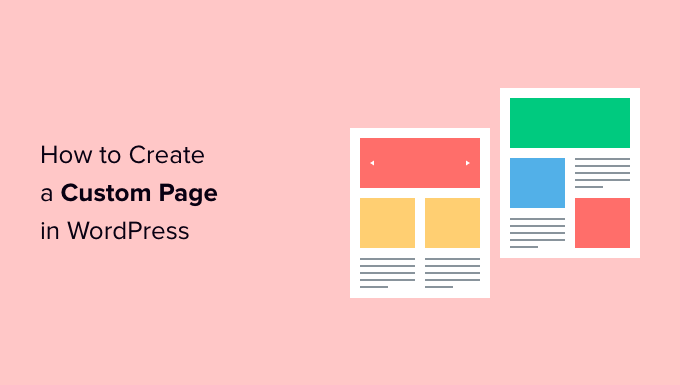
¿Por qué crear una página personalizada en WordPress?
Cada vez que creas una nueva página, tu tema de WordPress controla cómo se ve esa página utilizando un archivo de plantilla.
Esta plantilla page.php afecta a todas las páginas individuales que creas en WordPress. Sin embargo, es posible que no quieras usar el mismo diseño cada vez.
Las páginas de destino a menudo tienen contenido diferente en comparación con las páginas normales, como una gran imagen principal o una llamada a la acción (CTA). Esto significa que a menudo se ven completamente diferentes al resto de tu sitio web.
Sin embargo, intentar crear diseños únicos utilizando la plantilla de página estándar puede llevar mucho tiempo. También estás limitado por la plantilla page.php y es posible que no puedas crear el diseño exacto que deseas. Esto puede dificultar la obtención de buenos resultados. Por ejemplo, si estás creando una página de ventas, es posible que no obtengas muchas conversiones debido a un diseño de página deficiente.
Dicho esto, veamos cómo puedes crear una página personalizada en WordPress, con el diseño, la disposición y el contenido exactos que deseas. Simplemente usa los enlaces rápidos a continuación para ir directamente al método que deseas utilizar.
- Método 1. Cómo crear una página personalizada en WordPress usando el editor de bloques (no se requiere plugin)
- Método 2. Cómo crear una página personalizada usando el editor de sitio completo (solo temas basados en bloques)
- Método 3. Crea una página personalizada en WordPress usando SeedProd (recomendado)
- Método 4. Usar Thrive Architect para crear una página personalizada en WordPress
Método 1. Cómo crear una página personalizada en WordPress usando el editor de bloques (no se requiere plugin)
El editor de bloques facilita el diseño de tus propias plantillas utilizando las herramientas con las que ya estás familiarizado.
Esta es una buena opción si planeas reutilizar el mismo diseño en varias páginas, ya que puedes aplicar la misma plantilla. Si deseas crear un diseño completamente único, otra opción es crear la página de forma normal y luego editar su diseño usando el editor de sitio completo, que cubriremos en el Método 2.
Solo ten en cuenta que estos métodos solo funcionan con temas basados en bloques como ThemeIsle Hestia Pro o Twenty Twenty-Three. Si no tienes un tema basado en bloques, te recomendamos usar un constructor de páginas en su lugar.
Para empezar, simplemente abre cualquier página o publicación. Luego, selecciona la pestaña 'Página' en el menú de la derecha y haz clic en el texto junto a 'Plantilla'.
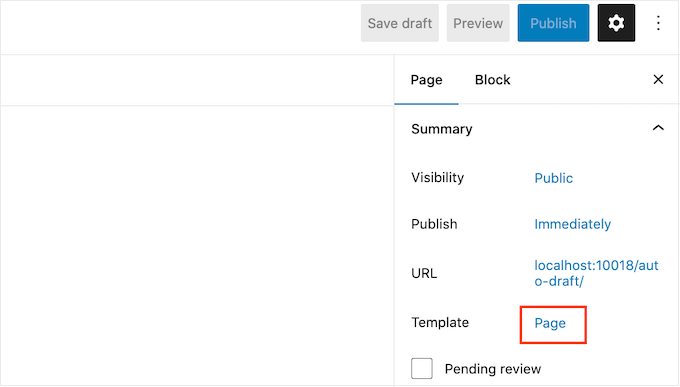
Las opciones que veas pueden variar según tu tema de WordPress, pero el texto generalmente mostrará 'Página', 'Plantilla predeterminada' o algo similar.
En la ventana emergente que aparece, haz clic en el ícono 'Agregar plantilla'.
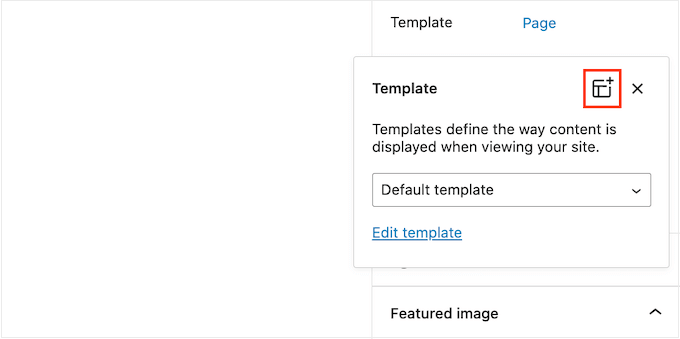
En la ventana emergente que aparece, escribe un nombre para tu plantilla y luego haz clic en 'Crear'.
El nombre es solo para tu referencia, así que puedes usar lo que quieras.
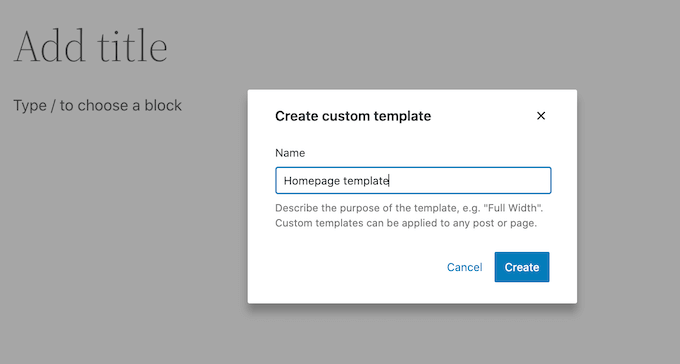
Esto inicia el editor de plantillas, que funciona de manera similar al editor de contenido de WordPress.
Para agregar bloques al diseño de página personalizado, simplemente haz clic en el botón azul '+'. Luego puedes arrastrar y soltar para agregar bloques.
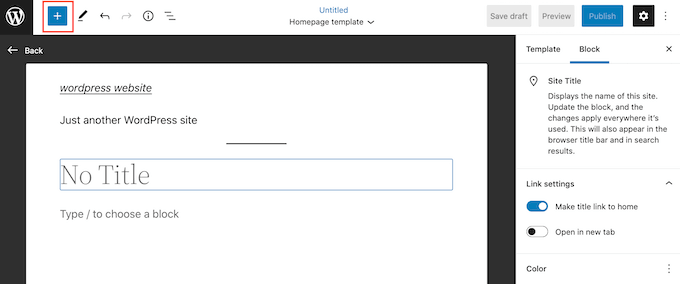
Puedes agregar contenido a un bloque o cambiar su formato usando las herramientas familiares de edición de publicaciones de WordPress. Por ejemplo, puedes escribir texto en un bloque de 'Encabezado', aplicar formato en negrita o cambiar el texto de H2 a H3.
También puedes crear una página personalizada usando patrones. Los patrones son colecciones de bloques que se usan a menudo juntos, como una lista de eventos, una imagen con un subtítulo, o una tabla de precios.
Los patrones que veas variarán según tu tema de WordPress, pero puedes ver qué patrones están disponibles haciendo clic en la pestaña ‘Patrones’.
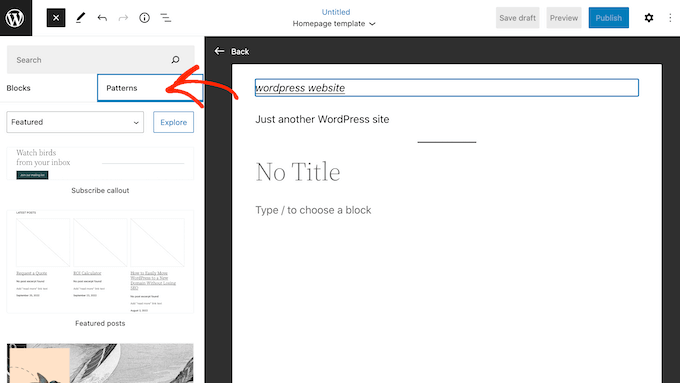
Puedes arrastrar y soltar un patrón de bloques en tu diseño o hacer clic en el patrón para agregarlo al final de tu plantilla. Cuando estés satisfecho con el aspecto de la plantilla, haz clic en el botón ‘Publicar’ y luego en ‘Guardar’.
Ahora puedes aplicar esta plantilla a cualquier página. Simplemente abre la página en el editor y luego haz clic en el texto junto a ‘Plantilla’.
En la ventana emergente que aparece, selecciona la plantilla que acabas de crear.
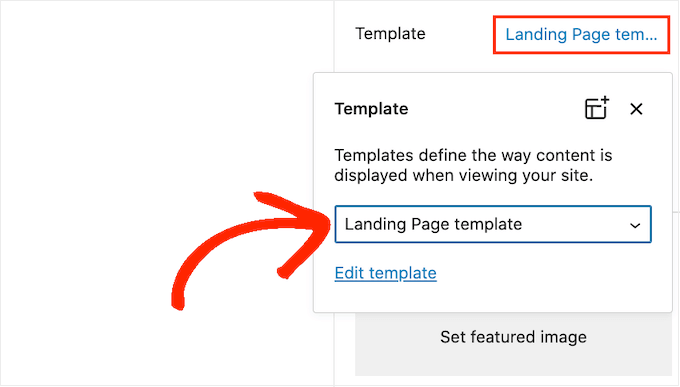
Hecho esto, puedes agregar contenido a la página, como a cualquier otra página de WordPress.
Método 2. Cómo crear una página personalizada usando el editor de sitio completo (solo temas basados en bloques)
Si estás usando un tema basado en bloques, también puedes crear una página personalizada usando el editor de sitio completo. Esto te permite cambiar el diseño de una página individual, sin crear una plantilla personalizada.
Teniendo esto en cuenta, esta es una buena opción si deseas crear un diseño completamente único que no reutilizarás en ninguna otra página.
Para empezar, simplemente crea la página como de costumbre yendo a Páginas » Añadir nueva. Luego puedes escribir un título, añadir categorías y etiquetas, subir una imagen destacada y hacer cualquier otro cambio que desees.
Cuando estés satisfecho con la página básica, guarda tus cambios y luego ve a Apariencia » Editor.
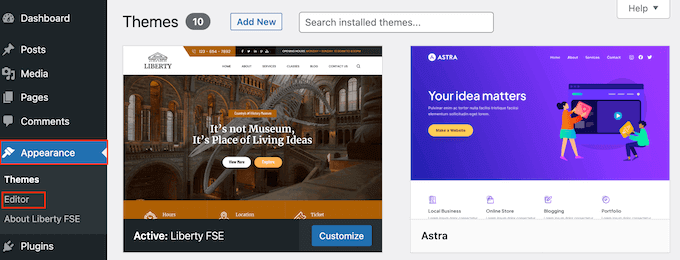
Por defecto, el editor de sitio completo muestra la plantilla de inicio de tu tema.
En el menú de la izquierda, haz clic en 'Páginas'.
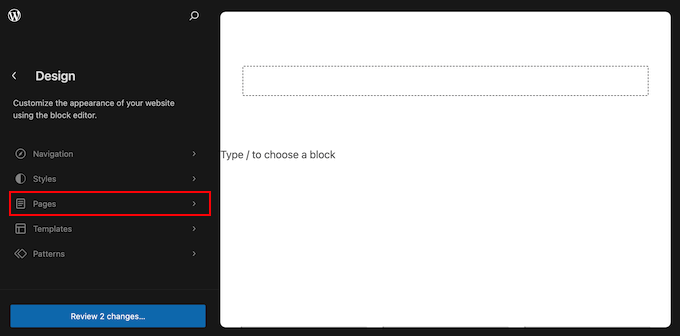
Ahora verás todas las páginas que has creado en tu sitio web de WordPress.
Simplemente encuentra la página que quieres rediseñar y haz clic en ella.
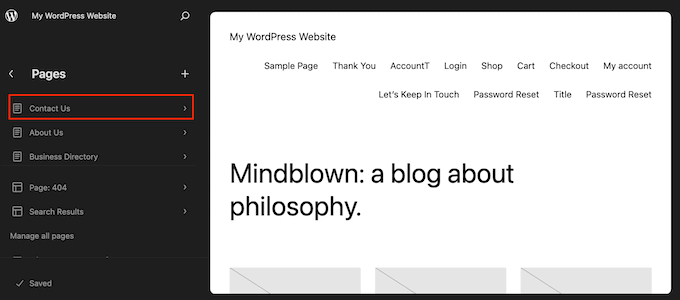
WordPress ahora mostrará una vista previa del diseño.
Para continuar y editar esta plantilla, haz clic en el pequeño icono del lápiz.
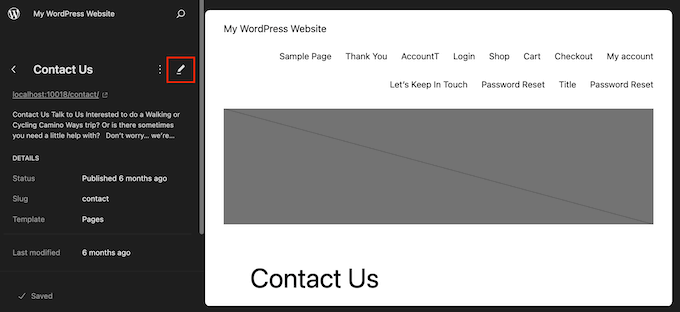
Ahora puedes editar el diseño de la página usando las herramientas del editor de sitio completo. Por ejemplo, puedes hacer clic en el botón azul '+' para añadir nuevos bloques, o hacer clic para seleccionar cualquier bloque que quieras personalizar.
Cuando estés satisfecho con los cambios que has hecho, haz clic en el botón 'Guardar'.
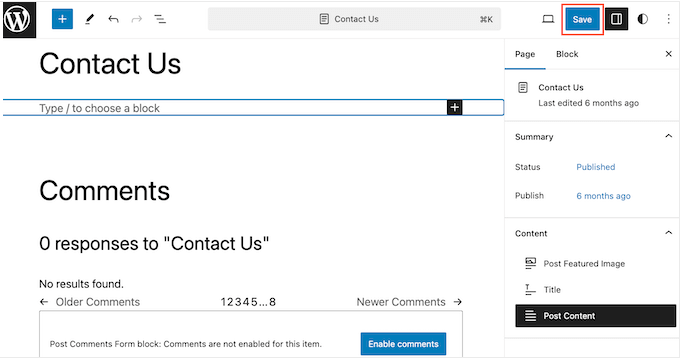
Ahora, si visitas esta página en tu sitio web, verás el nuevo diseño de página en acción.
Método 3. Crea una página personalizada en WordPress usando SeedProd (Recomendado)
En el pasado, creabas una página personalizada escribiendo código, lo cual no era muy amigable para principiantes. Si cometías un error con tu código HTML, CSS o PHP, podría causar errores comunes de WordPress o incluso romper tu sitio por completo.
Teniendo esto en cuenta, recomendamos usar un constructor de páginas en su lugar.
SeedProd es el mejor constructor de páginas de arrastrar y soltar para WordPress. Viene con más de 350 plantillas, lo que te permite crear páginas personalizadas sin escribir código.
Si estás usando una página personalizada para obtener más conversiones, entonces SeedProd funciona con muchas herramientas populares de terceros que podrías estar usando para obtener conversiones. Esto incluye los principales servicios de marketing por correo electrónico, WooCommerce, Google Analytics y más.
Primero, necesitas instalar y activar SeedProd. Para más detalles, consulta nuestra guía paso a paso sobre cómo instalar un plugin de WordPress.
Nota: También existe una versión gratuita de SeedProd que te permite crear páginas personalizadas sin importar tu presupuesto. Sin embargo, para esta guía, usaremos SeedProd Pro ya que tiene muchas más plantillas y se integra con todos los mejores servicios de marketing por correo electrónico.
Después de activar el plugin, SeedProd te pedirá tu clave de licencia.

Puedes encontrar esta información en tu cuenta en el sitio web de SeedProd. Después de ingresar la clave, haz clic en el botón 'Verificar clave'.
Elige una plantilla de página personalizada
Una vez que hayas hecho eso, ve a SeedProd » Páginas de destino y haz clic en el botón 'Agregar nueva página de destino'.
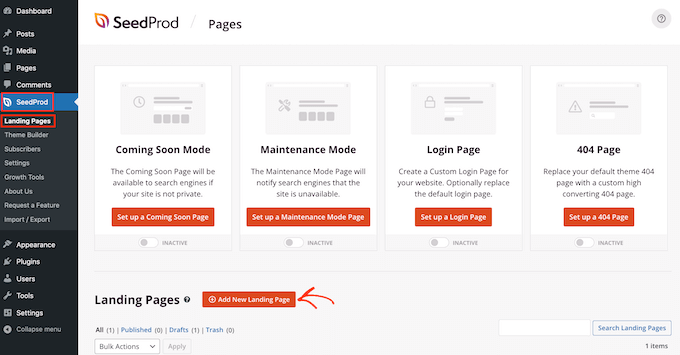
Ahora puedes elegir una plantilla para tu página personalizada.
Las plantillas de SeedProd están organizadas en diferentes tipos de campañas como 'lead', 'squeeze' y 'coming soon'. Puedes hacer clic en las pestañas en la parte superior de la pantalla para filtrar las plantillas según el tipo de campaña.
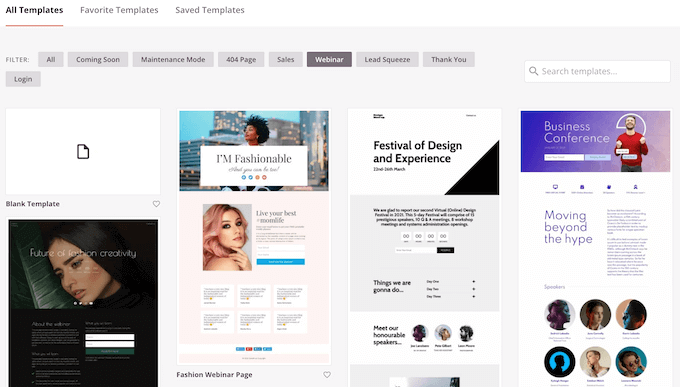
Si quieres empezar desde cero, SeedProd también tiene una plantilla en blanco que puedes usar.
Para ver de cerca cualquier diseño, simplemente pasa el cursor del ratón sobre esa plantilla y luego haz clic en el icono de la lupa.
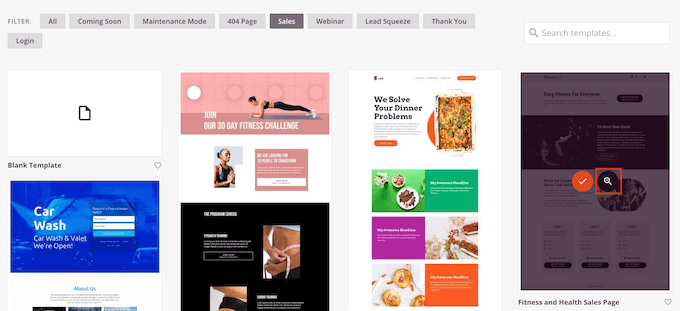
Cuando encuentres un diseño que te guste, haz clic en ‘Elegir esta plantilla’. Estamos usando la plantilla ‘Página de ventas de curso’ en todas nuestras imágenes, pero puedes usar la plantilla que quieras.
A continuación, escribe un nombre para la página personalizada. SeedProd creará automáticamente una URL basada en el título de la página, pero puedes cambiar esta URL por lo que quieras.
Una URL descriptiva también ayudará a los motores de búsqueda a entender de qué trata la página para que puedan mostrarla a los usuarios correctos, lo que mejorará tu SEO de WordPress.
Para darle a tu página personalizada la mejor oportunidad de aparecer en los resultados de búsqueda relevantes, es posible que desees agregar cualquier palabra clave que falte en la URL. Para más detalles, consulta nuestra guía sobre cómo hacer investigación de palabras clave.
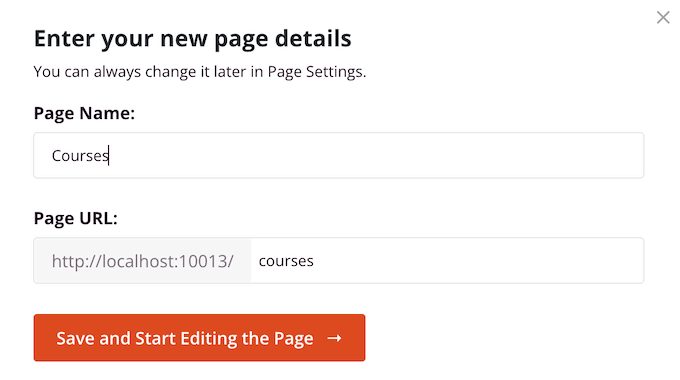
Cuando estés satisfecho con la información que has introducido, haz clic en el botón ‘Guardar y empezar a editar la página’.
Diseña tu página personalizada
SeedProd ahora abrirá la plantilla elegida en su editor de arrastrar y soltar fácil de usar. Verás una vista previa en vivo de tu página a la derecha y algunas configuraciones de bloques a la izquierda.

Para personalizar un bloque, simplemente haz clic para seleccionarlo en el editor de la página. La barra de herramientas de la izquierda mostrará todas las configuraciones de ese bloque.
En la siguiente imagen, estamos cambiando el texto dentro de un bloque de ‘Encabezado’.
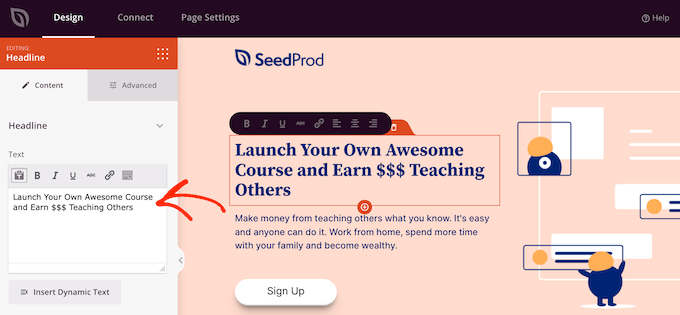
Puedes formatear el texto, cambiar su alineación, agregar enlaces y más usando las configuraciones en el menú de la izquierda.
También es fácil editar imágenes usando el constructor de páginas de SeedProd. Simplemente haz clic en cualquier bloque de 'Imagen' y usa las configuraciones para agregar texto alternativo, subir una nueva imagen o hacer cualquier otro cambio.
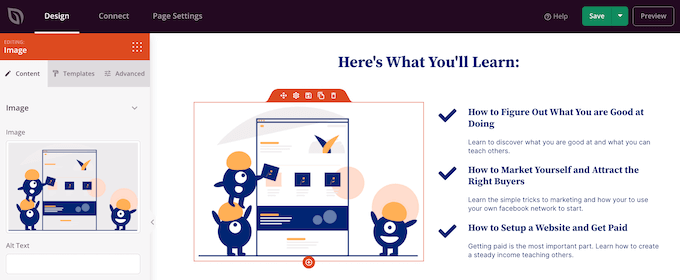
Si deseas eliminar un bloque de la página personalizada, simplemente haz clic para seleccionarlo.
Luego, haz clic en el ícono del bote de basura en la mini barra de herramientas.
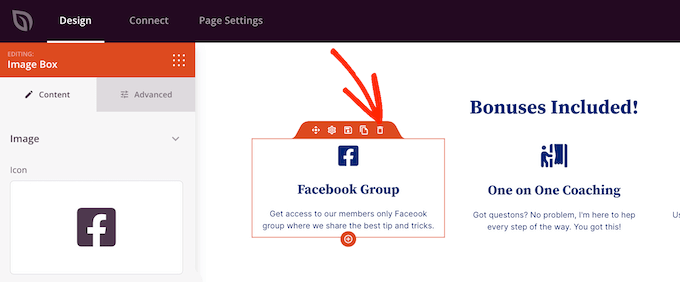
Para agregar nuevos bloques a tu diseño, solo busca un bloque en el menú de la izquierda y arrástralo al editor.
Luego puedes hacer clic para seleccionar el bloque y hacer cualquier cambio en el menú de la izquierda.
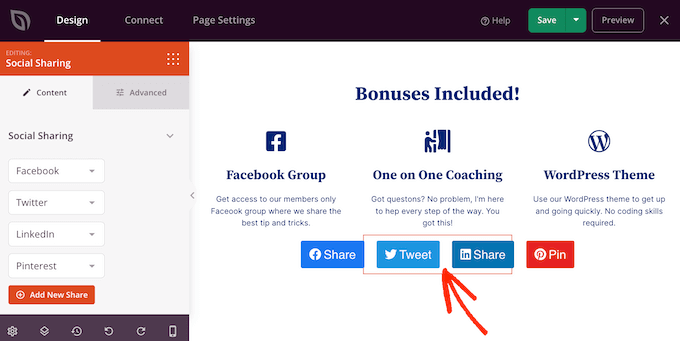
SeedProd también viene con ‘Secciones’, que son filas y plantillas de bloques que pueden ayudarte a crear una página personalizada, rápidamente. Por ejemplo, si estuvieras diseñando una página de destino para anuncios de Google, entonces podrías usar las secciones listas para usar de Héroe, Llamada a la acción o Características de SeedProd.
Para ver todas las secciones disponibles, simplemente haz clic en la pestaña ‘Secciones’.
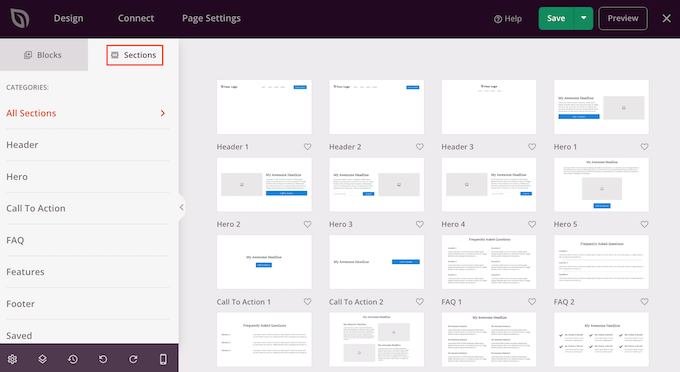
Para ver una sección más de cerca, pasa el ratón sobre ella y luego haz clic en el icono de la lupa.
Cuando encuentres una sección que quieras añadir a tu diseño, simplemente mueve el ratón sobre ella y luego haz clic en el pequeño icono de ‘+’.
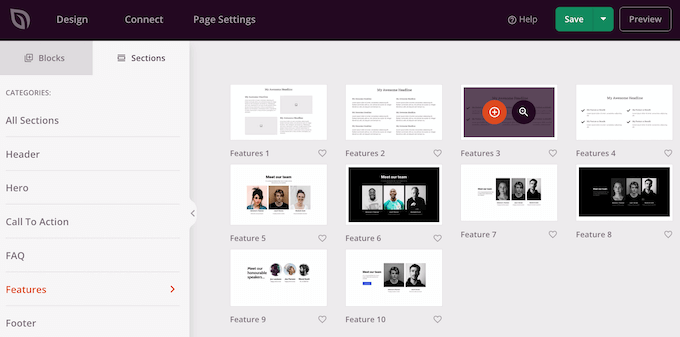
Esto añade la sección al final de tu página. Puedes mover tanto secciones como bloques dentro de tu diseño usando arrastrar y soltar.
Si cometes un error o cambias de opinión, no te preocupes. Puedes deshacer tu último cambio haciendo clic en el botón ‘Deshacer’ en la parte inferior de la barra de herramientas izquierda.
Aquí, también encontrarás un botón de rehacer, historial de revisiones, navegación de diseño y configuración global.
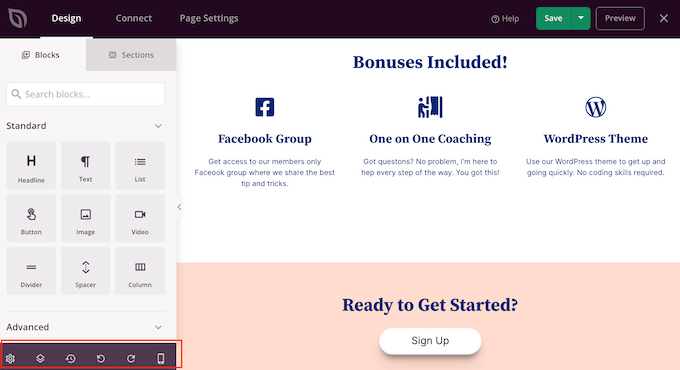
Estos botones adicionales facilitan la creación de una página personalizada en WordPress.
En la parte inferior de la barra de herramientas, también encontrarás un botón de vista previa móvil que te permite ver la versión móvil de la página personalizada.
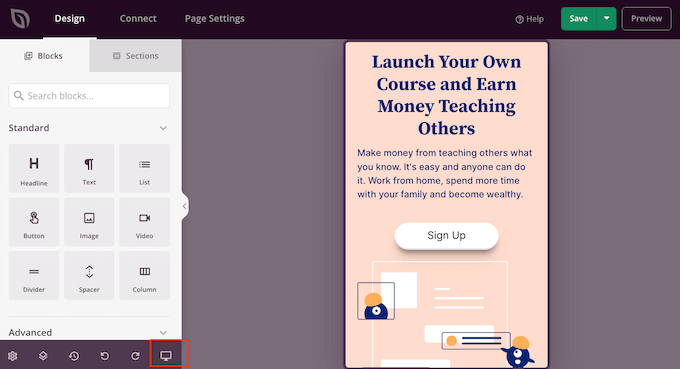
Esto puede ayudarte a diseñar una página personalizada que se vea tan bien en dispositivos móviles como en tu computadora.
Cuando estés satisfecho con la página personalizada, es hora de publicarla haciendo clic en la flecha desplegable junto a ‘Guardar’ y luego seleccionando la opción ‘Publicar’.
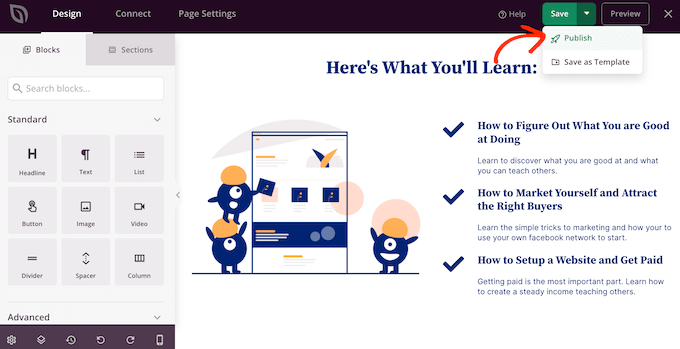
Tu página personalizada ahora estará activa en tu blog de WordPress.
Si deseas editar la página personalizada en cualquier momento, simplemente ve a SeedProd » Landing Pages en tu panel de WordPress. Luego, podrás encontrar la página que deseas modificar y hacer clic en su enlace ‘Editar’.
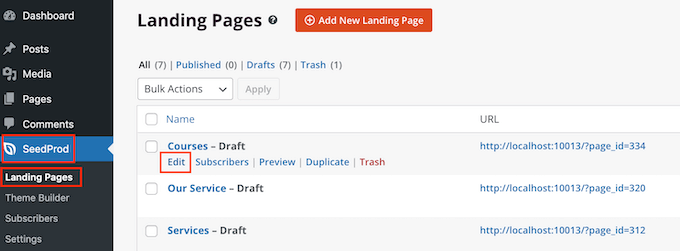
Esto abrirá el diseño en el editor de SeedProd, listo para que realices tus cambios.
Método 4. Usar Thrive Architect para crear una página personalizada en WordPress
También puedes crear una página personalizada usando Thrive Architect. Thrive Architect es otro popular constructor de páginas de arrastrar y soltar para WordPress.
Viene con más de 300 plantillas diseñadas profesionalmente que están hechas para ayudarte a obtener más conversiones.

Primero, necesitas instalar y activar el plugin Thrive Architect. Para más detalles, consulta nuestra guía paso a paso sobre cómo instalar un plugin de WordPress.
Tras la activación, ve a Páginas » Añadir Nueva en tu panel de administración de WordPress para crear una página personalizada. Luego, haz clic en el botón ‘Lanzar Thrive Architect’.
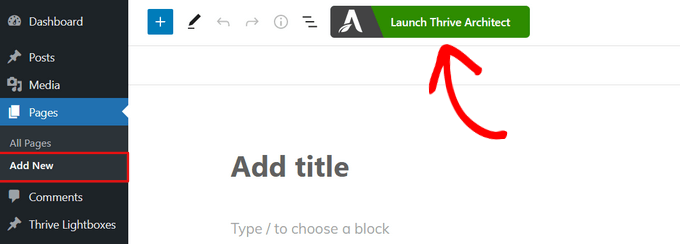
A continuación, puedes elegir si crear una página normal o una página de destino preconstruida.
Recomendamos hacer clic en ‘Página de destino preconstruida’, ya que te da acceso a todas las plantillas de página de destino de Thrive. Estas plantillas son totalmente personalizables, por lo que puedes ajustarlas para que se adapten a tu sitio web de WordPress.
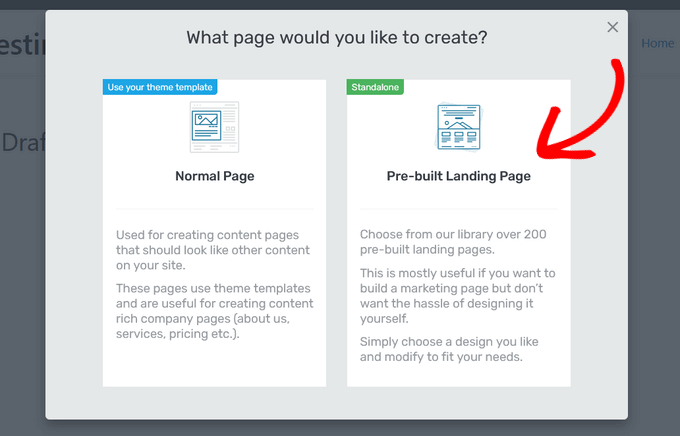
Cuando encuentres un conjunto que te guste, simplemente haz clic para seleccionarlo.
En la siguiente imagen, estamos seleccionando ‘Conjuntos de páginas de destino inteligentes’.
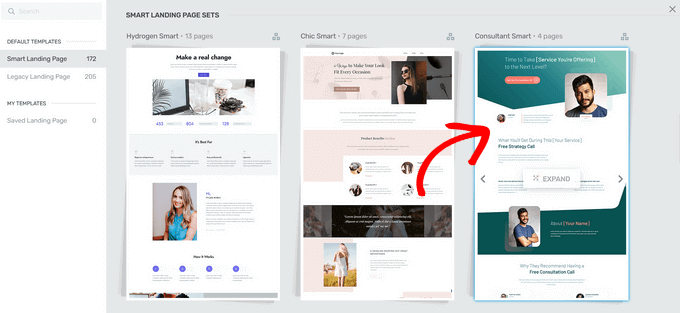
En la siguiente pantalla, necesitas elegir una plantilla específica del conjunto.
Selecciona una plantilla haciendo clic en ella y luego presionando el botón ‘Aplicar Plantilla’.
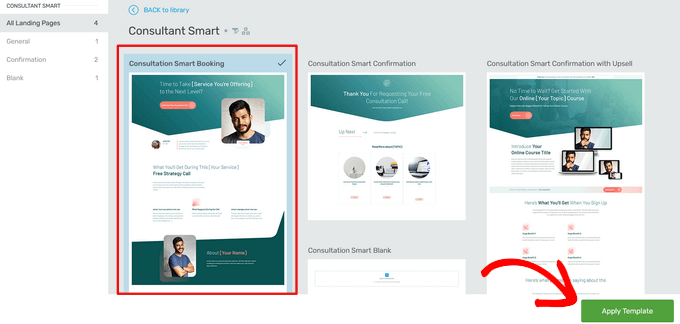
Esto abrirá la plantilla en el Editor de Thrive Architect. Desde aquí, puedes personalizar fácilmente la plantilla de página para que coincida con tu blog, sitio web o tienda en línea.
Como ejemplo, puedes cambiar el 'Encabezado' haciendo clic en él y luego escribiendo tu propio mensaje personalizado.
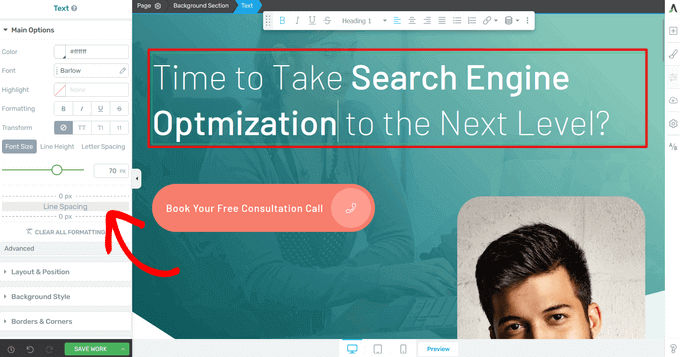
Ahora verás todas las opciones de personalización en el menú de la izquierda. Aquí, puedes cambiar la tipografía, el tamaño de fuente, el color, el formato y más.
Desde el panel izquierdo, también puedes ajustar otras configuraciones para tu página personalizada, como el diseño, el estilo de fondo, bordes, animaciones y comportamiento de desplazamiento, solo por nombrar algunas.
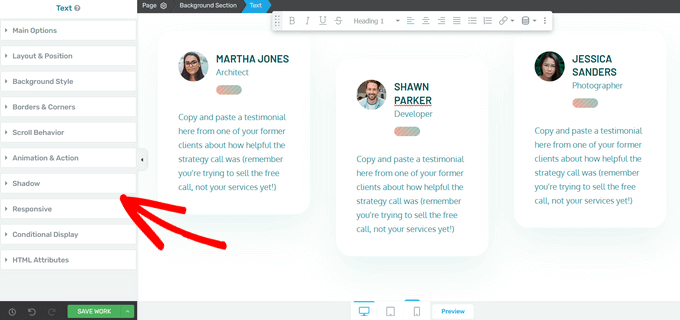
Similar a los bloques de SeedProd, Thrive Architect viene con muchos elementos preconstruidos que puedes agregar a tu página personalizada.
Para agregar un nuevo elemento a la página, haz clic en el botón 'Agregar Elemento (+)' en el lado derecho de la pantalla.
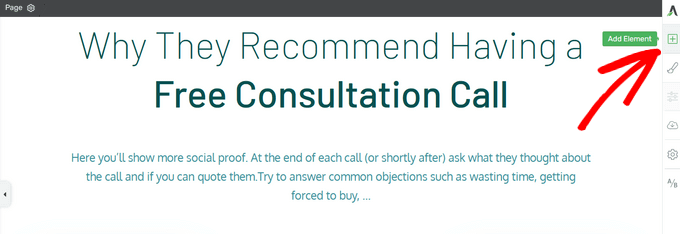
Ahora puedes elegir entre elementos como imágenes, botones, formularios de generación de leads, tablas de precios, temporizadores de cuenta regresiva y más.
Para agregar un elemento, simplemente arrástralo desde el menú de la derecha y suéltalo en tu página.
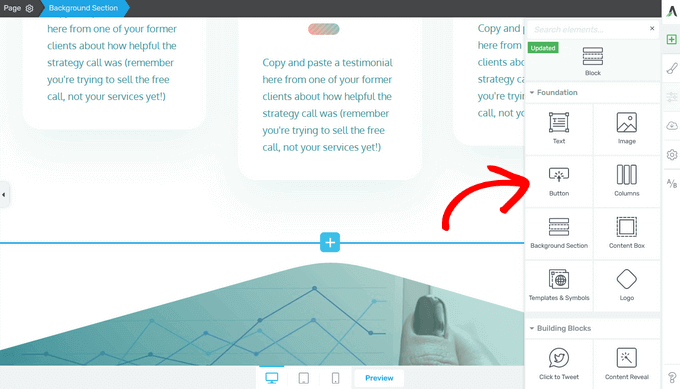
De nuevo, puedes editar cualquiera de los nuevos elementos que agregues a tu página haciendo clic en ellos.
Cuando estés satisfecho con el aspecto de la página, haz clic en la flecha (^) junto al botón 'Guardar trabajo'. Luego, haz clic en la opción 'Guardar y volver al editor de publicaciones'.
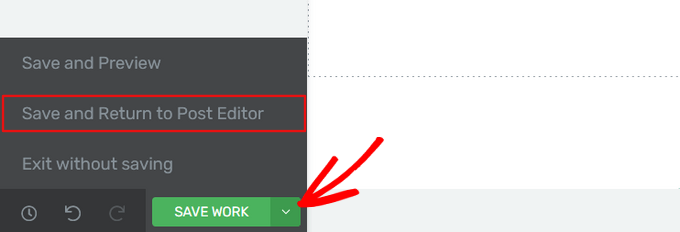
Luego puedes guardar la página como borrador, o publicarla para que aparezca en tu sitio web de WordPress.
Una vez que tu página personalizada se publique, puedes visitar tu sitio para verla en acción.
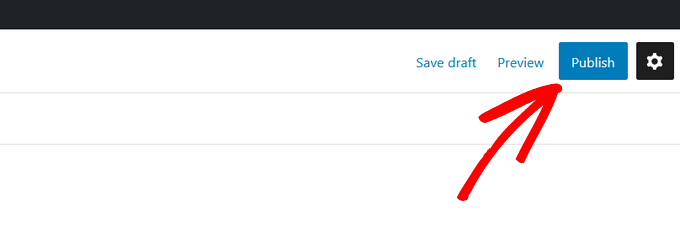
Esperamos que este artículo te haya ayudado a aprender cómo crear una página personalizada en WordPress. También te puede interesar nuestra guía sobre cómo crear una página de destino con WordPress y cómo dividir el título de una publicación o página en WordPress.
Si te gustó este artículo, suscríbete a nuestro canal de YouTube para obtener tutoriales en video de WordPress. También puedes encontrarnos en Twitter y Facebook.





Hemant Kuswah
Hiii, Gracias por la información.
Tengo un pequeño problema/confusión. Hice la página personalizada como describiste en el tutorial anterior. Pero quiero agregar código php personalizado para obtener datos de otro lugar y mostrarlos en la página personalizada que acabo de crear.
Habrá un menú desplegable en la página personalizada y al seleccionar un valor, se mostrarán algunos datos en la misma página que provienen de la base de datos o de algún otro sitio web.
¿Cómo puedo hacer eso?
Any suggestion ?
?
Thanks
Jared
Hola, me preguntaba cómo puedo evitar incluir CSS y archivos JS de otros plugins como woocommerce y varios otros en mi plantilla.
Gracias,
J.
Valerio
¿Qué pasa si el tema tiene una especie de wrapper base.php? Me gustaría crear una nueva plantilla de página personalizada, pero siempre obtengo también lo que está en el wrapper base.php principal. ¿Me he explicado con suficiente claridad?
Dre
¿qué tal este?
Quiero la barra lateral a la extrema derecha y todo el demás contenido “ancho completo” en la página. ¿Cómo puedo hacer esto?
Cuando elijo “Ancho completo” en la Configuración del sitio de WordPress, la barra lateral, por supuesto, desaparece y mi contenido todavía no tiene ancho completo.
puedes ver mi página aquí:
¡gracias!
Yazhini
¿Cómo hacer una conexión de cliente FTP?
Soporte de WPBeginner
Hola Yazhini,
Necesitarás ingresar el dominio de tu sitio web, el nombre de usuario y la contraseña de FTP. Para obtener instrucciones detalladas, consulta nuestra guía sobre Cómo usar FTP para subir archivos a WordPress.
Administrador
Yiani
¿No aparece nada en el menú desplegable de Atributos de página? Estoy usando el tema Storefront para Woocommerce. ¿Cuál es la solución? ¿Storefront no permite plantillas de página personalizadas? Cualquier ayuda es muy apreciada. Gracias.
Henry
Muy educativo, de verdad, muchas gracias. Sin embargo, tengo una situación bastante particular y después de leer tu publicación sentí que debía preguntar. Tengo dos páginas encantadoras que anhelo agregar a mi tema de WordPress, pero lamentablemente son páginas HTML estáticas con sistema de comentarios, votación y compartición. ¿Hay alguna manera de que pueda incluirlas en mi tema de WordPress existente y también hacer que utilicen los sistemas de comentarios, votación y compartición de WordPress?
Ketan Chaudhari
Gracias por este tutorial.
Hoy, me das la oportunidad de aprender algo nuevo en WordPress.
Natacha
Gracias por el tutorial. Me da gusto aprender cosas nuevas paso a paso.
Pero, cuando previsualizo la página con la nueva plantilla, no tengo una página en blanco, tengo mi tema predeterminado cargado.
¿Cómo puedo cambiar eso?
Soporte de WPBeginner
Hola Natacha,
Puedes hacer clic en Apariencia y luego seleccionar un tema. Consulta nuestra guía sobre cómo instalar un tema de WordPress para obtener instrucciones detalladas.
Administrador
Natacha
Gracias por la respuesta.
Pero, no puedo cambiar el tema de todo mi sitio web. Solo necesitaba crear una página en blanco para poder crear un foro.
Hero
En lugar de reinventar la rueda, ¿por qué no usar BuddyPress?
Tim
¡Solo quiero AGRADECERTE por publicar esto! He estado intentando que una página de inicio estática funcione con mi plantilla personalizada y no encontraba una respuesta clara y sencilla hasta que me topé con este artículo. Muy apreciado.
Soporte de WPBeginner
Hola Tim,
You are welcome Don’t forget to follow us on Facebook for more WordPress tips and tutorials.
Don’t forget to follow us on Facebook for more WordPress tips and tutorials.
Administrador
hamed ahmed
Gracias, la consola de búsqueda de Google requiere guardar un archivo .html en mi sitio web de WordPress, pero .html no aparecerá en el sitio web. ¿Alguien puede ayudarme, por favor, porque quiero registrar mi sitio web en la consola de búsqueda.
Soporte de WPBeginner
Hola Hamed,
También puedes verificar agregando la metaetiqueta o usando el plugin Yoast SEO, que te permite agregar la metaetiqueta desde su página de configuración.
Administrador
Sameer Kumar
¿Cómo eliminar la barra lateral de PHP?
KH
No veo la opción de plantilla en la sección de Atributos de página de mi página de WordPress. ¿Hay algo que deba hacer para ver esto?
Yasser
Muchas gracias.
Funcionó perfectamente.
Luis
¡Gracias por la publicación! Fue muy difícil encontrar esta respuesta simple en el codex de WordPress. Sin embargo, una sugerencia. Por favor, agregue a su publicación que cuando los usuarios creen su archivo 'custom_page.php', agreguen una etiqueta de encabezado, es decir, con un título de texto para que no obtengan una página en blanco al principio. Es solo una forma rápida de asegurarse de que la página realmente esté funcionando. ¡Nuevamente, muchas gracias por hacerlo tan fácil!
ashkan 261
Muy genial, muchas gracias querido
AltisB
Estoy intentando incrustar algunos códigos de JavaScript o HTML en la página en blanco... ¿cómo debería hacerlo? Porque ahora tengo la página en blanco, pero cuando incrusto los códigos incrustados en el editor, no parece funcionar.
kray
¿Cómo haces esto para WordPress 4.7? No aparece ninguna plantilla cuando intento crear una página en 4.7.
Altisb
“Una vez que hayas agregado el código, guarda el archivo en tu escritorio como, custompaget1.php.”
Mi bloc de notas guarda el archivo como .txt
¿Cómo lo guardas como archivo .php???
Soporte de WPBeginner
Hola,
Intenta usar 'Guardar como' en lugar de la opción guardar del menú archivo. Al usar guardar como, escribe el nombre completo de tu archivo. También puedes renombrar el archivo existente custompaget1.php.txt a custompaget1.php
Administrador
Ben
Soy un principiante total y encontré los pasos fáciles de seguir. Creé mi nuevo archivo .php siguiendo las instrucciones, pegando el texto de page.php al final de mi nuevo archivo .php. Estoy en el punto donde mi nueva plantilla de página personalizada está disponible en el menú desplegable cuando creo una nueva página. Selecciono la nueva plantilla para la nueva página y, cuando hago cambios en la nueva página en el personalizador (elimino un widget de texto de la barra lateral), los cambios se aplican a otras páginas que tienen la plantilla predeterminada seleccionada también, no solo a mi nueva página con la nueva plantilla personalizada seleccionada. ¿Alguna idea?
Marshall
Encontré esto muy útil. Sin embargo, tuve un problema. Cuando voy a la nueva página
hay un margen superior de 32px en ella que no se muestra en la otra página.
Logan
Hola,
Tengo un problema con mis páginas de WP. Tengo un sitio web en funcionamiento y recientemente necesité agregar una nueva página y un nuevo botón de menú. He creado un nuevo botón de menú y creado una nueva página (plantilla predeterminada) y la he publicado. Sin embargo, en el sitio web, después de hacer clic en el nuevo botón debajo del cual debería estar esta nueva página, solo se muestra la cabecera y el pie de página. No mi nueva página.
¿Podrías ser tan amable de aconsejarme sobre esto? Soy un principiante total en WP, así que crear mi propia página de plantilla está fuera de discusión y tenía la impresión de que simplemente agregar una nueva página a mi sitio web de WP solo debería estar a unos pocos clics de distancia...
Gracias
Soporte de WPBeginner
Hola Logan,
Por favor, consulta nuestra guía sobre cómo agregar menús de navegación en WordPress.
Administrador
Anish
¡Hola! Hice lo que dijiste.
Creé un archivo .php con el mismo fragmento de código que me diste y lo subí a mi carpeta /wp-content/themes. Ahora, cuando voy a la sección de Páginas en WordPress, no hay opción para elegir la Plantilla. ¿Qué debo hacer? ¿Puedes averiguar en qué me estoy equivocando?
Leonardo
Hola. No sé nada de PHP y necesito crear una página personalizada para mi sitio web.
¿Es posible crear una página HTML desde cero, incluir JavaScript en la página y ponerla en el archivo .php como se describe?
Gracias.
Soporte de WPBeginner
Hola Leonardo,
Aún necesitarás usar PHP para las etiquetas de plantilla de WordPress.
Administrador
Mo
@DAN ¿Estás seguro de que estás incluyendo el encabezado? Ahí es donde WP normalmente encolará tu style.css
Dan
Hola,
Estoy intentando crear una plantilla en blanco para usarla como página de destino. Logré crear la plantilla en blanco, pero ahora cuando intento agregar contenido (usando el editor de WP, Visual Composer o incluso un formulario de contacto CF7) no se aplica ningún estilo. ¿Hay alguna forma de decirle a la plantilla que use el estilo CSS del tema?
Gracias
Marco Milano
Esto no es un nuevo tipo de publicación, sino una nueva plantilla. Son dos cosas diferentes. De hecho, puedes llamar a una plantilla desde una publicación, mientras que el tipo de publicación personalizado tiene un espacio personal en el panel de administración.
Julie
Seguí todos los pasos y funcionaron hasta que intenté seleccionarlo en la parte de “Atributos de página”. ¡“CustomPageT1” simplemente no es una opción en el menú desplegable!
¿Qué puedo hacer para que WordPress y/o mi tema puedan detectar que es una plantilla?
¡Gracias de antemano!
Julie
Soporte de WPBeginner
La mayoría de las veces los usuarios cometen errores al copiar y pegar fragmentos de código. Por favor, asegúrate de que tu archivo de plantilla personalizado contenga exactamente el mismo código
<?php /* Template Name: CustomPageT1 */ ?>Administrador
Ubaid
Quiero agregar una imagen de encabezado de ancho completo antes de todo el contenido y la barra lateral. ¿Cómo puedo hacerlo?
Girija Tandel
Muchas gracias por este maravilloso tutorial.
Me ayuda mucho.
Funciona genial.
Harish S Reddy
¡Gracias, funciona genial!
Soporte de WPBeginner
Hola Harish, me alegra que te haya resultado útil. No olvides seguirnos en Facebook para más consejos y tutoriales de WordPress.
Administrador
Charmy Dexter
Era como si estuviera leyendo 123. Espero que una plantilla de página de un tema se pueda usar en otro tema.
Uchenna
por favor, ¿puedes ayudarme? Tengo dos temas. uno para mi vista de escritorio y el otro para móvil. usé cualquier cambiador de móvil para que la vista móvil funcionara. Diseñé una página estática para el tema de escritorio y aquí es donde comienza mi problema, porque una vez que configuro desde “lectura” para usar la página de inicio estática para el tema de escritorio, la página de inicio del tema móvil deja de mostrar publicaciones. ¿hay alguna manera de que esto funcione? este es el sitio del que estoy hablando, gracias de antemano
Matthew
Mucho más fácil de lo que pensaba. ¡Gracias!
Rahul Tiwari
Hola,
Me es muy útil y muy fácil de entender.
Gracias
jass
thank you very much.This article really helps
Steven Denger
Para un "principiante", esto no fue útil. No explicaste los pasos con más detalle, como "ve a la carpeta de tu tema actual" – ¿cómo hago esto? Y tus instrucciones de FTP fueron demasiado vagas. Si hubiera podido entender tus instrucciones, no habría necesitado este wp-beginner en primer lugar, ya que está explicado para aquellos que tienen más experiencia técnica.
Estos tutoriales no fueron nada útiles y solo están dirigidos a los espectadores más técnicos.
¡NO HAY AYUDA AQUÍ EN ABSOLUTO!
Soporte de WPBeginner
Hola Steven,
Lamentamos que no hayas encontrado útil este artículo. Intentaremos explicarlo en los comentarios.
Para conectarte a la carpeta de tu tema, necesitarás un cliente FTP. Estos son programas especiales que te permiten conectarte a tu servidor web y subir, eliminar y administrar tus archivos directamente.
Cuando te registras con un proveedor de hosting de WordPress, te envían un correo electrónico con tus credenciales de inicio de sesión FTP. Si no recibiste este correo electrónico, por favor, ponte en contacto con tu proveedor de hosting por chat o correo electrónico y te los enviarán de inmediato.
Sin embargo, si usar FTP te parece un poco difícil, también puedes usar el Administrador de Archivos. Es una aplicación basada en web disponible en tu cuenta de hosting web. Inicia sesión en tu cuenta de hosting web y busca Administrador de Archivos.
Let us know if you need more help
Intentaremos mejorar y hacer nuestros artículos aún más amigables para principiantes en el futuro.
Administrador
Niki
Many thank you for simple and informative article helped me to start
Chibuike Mba
Muchas gracias, este artículo sobre páginas personalizadas realmente me ha indicado la dirección correcta para lo que necesitaba anular la página del tema en mi plugin para algunos tipos de publicaciones personalizadas.
Gracias una vez más.
Soporte de WPBeginner
Nos alegra que te haya resultado útil :) No olvides seguirnos en Twitter para más consejos y tutoriales de WordPress.
Administrador
Wayne from Keys English
Hola,
¿Qué puedo hacer si veo la transferencia exitosa de custompageT1 a mi cliente FireFTP, pero cuando voy a la administración de WP – creo una nueva página – me desplazo hacia abajo hasta la plantilla, custompageT1 no está en la lista desplegable para seleccionar?
Gracias
Wayne
zamaan
Excellent, very useful. Thank you.
but u fogot to tell where i want to add my custom php code in the template file
Jaczkowski
Aprendí algo nuevo. Muchas gracias
Janet Fuller
Esto es realmente extraordinario. Generalmente, agrego una página y luego la creo. Pero hoy, he aprendido algo nuevo.
nevenx
Hola,
¿es posible integrar otro script a wp (por ejemplo, el script de faucetbox) de esta manera?
Soporte de WPBeginner
Puedes hacerlo, pero sería mejor crear un plugin para eso.
Administrador
San
Gran artículo. Ayuda a aliviar mi confusión
Tak
gracias por el tutorial muy conciso con ejemplos sencillos. ¡fue súper fácil de seguir!
Radhakrishnan
Estimado señor,
Hice lo que dices. pero en la pantalla de edición de mi página no aparece ninguna plantilla en el atributo. ¿qué puedo hacer, señor?
levan
muchas gracias, mi estimado, es muy útil
Gabriel
Este es un gran tutorial. Muy simple y fácil de seguir. ¡Gracias!
Waleed Barakat
¡Gracias por el tutorial! De hecho, tengo una plantilla de WordPress para juegos y cada vez que intento crear una página, la trata como un juego y no muestra el contenido de la página como de costumbre, pero creo que todo estará bien después de leer y aplicar este tutorial en mi sitio web:
Gracias de nuevo